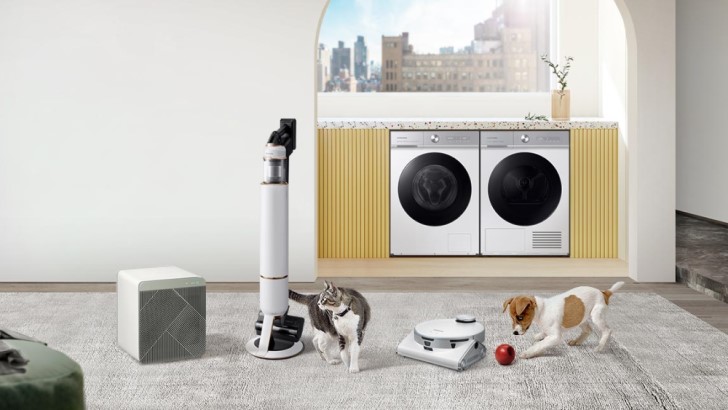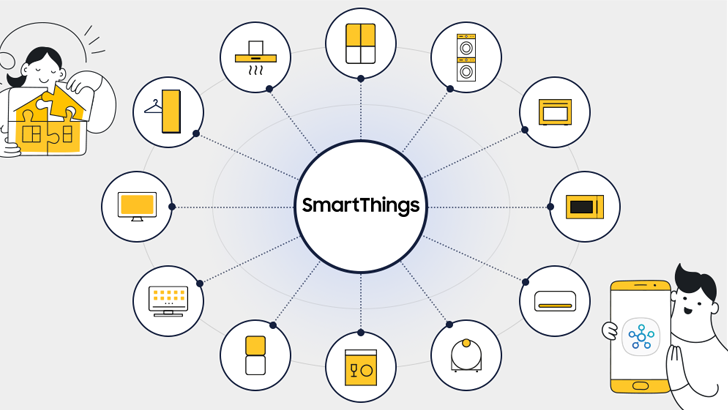[Interview] Keep the Temperature Low and Electric Bills Lower: Useful Air Conditioner Tips From Samsung Engineers
on August 9, 2023
Many researchers and engineers at Samsung Electronics publish verified data collected from their projects as research papers. While some advanced studies make it into world-renown journals like Nature, many studies also explore topics that are relevant to consumers’ daily lives including energy saving, wind-free air conditioning, dehumidifying and more. With much of the world experiencing intense hot weather due to global heat waves caused by climate change and El Niño, Samsung Newsroom sat down with Samsung engineers to share some useful, research-backed tips on how consumers can best utilize their air conditioners.

▲ (From the left) Seongjin Lim, Sangwoo Lee, Jun Hwang and Hyeongkyu Cho from Samsung Electronics’ Air Solution R&D Group

▲ Cover pages of research papers recently published by members of the Air Solution Lab
#1 Use Dry Mode on Highly Humid Days
In the summer, high humidity can be more unpleasant for people than the hot weather itself. In these instances, the engineers recommend using different air conditioner modes.
“It’s good to choose the right mode based on indoor conditions,” said Jun Hwang from the Air Solution R&D Group. “Air conditioners function by sucking in hot, humid air that goes through the cold Heat Exchanger inside the indoor unit before emitting cool air to lower indoor temperatures and humidity. While the basic functionalities of Cooling and Dry modes are similar, they work in different ways depending on the result you are trying to achieve.”

This raises the question: What is the difference between Cooling and Dry modes?
Put simply, Cooling is ideal for quickly lowering the indoor air temperature whereas Dry is perfect for reducing the humidity within a space. The biggest difference lies in the compressor and air volume.
The goal of Cooling is to match the temperature set by the user. After sensing the indoor temperature, the air conditioner emits cool air and adjusts the compressor output in the outdoor unit to maintain the desired temperature with minimal energy consumption.
Similarly, Dry (Dehumidification) mode is used to lower humidity as much as possible based on the temperature set by the user. The air conditioner removes moisture without changing the temperature by sensing both the indoor temperature and relative humidity before adjusting the air volume and compressor output. For example, if the target temperature has been met but not the humidity, the device will continue to run the compressor while reducing the air volume to extract moisture without further lowering the temperature.

▲ The residential environment test lab is simulated to resemble actual homes for effective research and development on how to use air conditioners.

▲ Samsung Electronics Digital Appliances (DA) Business (2015). An Experimental Study on Dehumidifying Efficiency and Thermal Comfort Improvement for the Inverter-driven Residential Air Conditioner. The Society of Air-Conditioning and Refrigerating Engineers of Korea, p253-256.
According to a research paper, engineers confirmed that Dry Mode was approximately 2.7 times more effective at removing moisture than Cooling Mode when operating at the same temperature in an environment mimicking high humidity periods. In fact, Dry decreased the relative room humidity from 75% to 55%, and the discomfort index dipped from 73 to 70 — with participants who felt discomfort dropping from 50% to 10%.
Since temperature and weather conditions fluctuate throughout the day, it can be a hassle to manually switch between modes. To optimize the cooling experience and maintain optimal room conditions, Samsung engineers recommend using AI Auto Cooling,1 which automatically switches to the most appropriate mode between WindFree™, Fast and Normal Cooling.

“The AI Auto Cooling feature switches to the appropriate mode that suits each user’s household by analyzing usage patterns and external conditions of both indoor and outdoor units,” said Hwang.
Usage patterns are sent to the AI server each day — with regular updates occurring every three to four days — to provide users with more a more personalized cooling experience.
#2 Digital Inverter Boost Promotes Energy Efficiency
People often avoid turning on their air conditioners for long periods of time over fears of spiked electricity bills. However, thanks to the highly energy-efficient Digital Inverter Boost technology, users can enjoy pleasantly cool rooms during the hot summer months while reducing energy usage up to 73%.

To understand why energy usage surges, Sangwoo Lee from the Air Solution R&D Group explained the differences between air conditioner operating time and occupied zone. “Sometimes, people briefly turn off their air conditioners before turning them on again when it gets hot — repeating this over and over because they’re worried about raising their electricity bills,” Lee said. “However, this can actually cause the bill to increase even more.”

Samsung engineers conducted tests to measure how much energy is saved when an air conditioner is turned off and on versus when an air conditioner is operating continuously. Although results may vary depending on the size of the area and the difference between the indoor and outdoor temperatures, the engineers concluded that keeping the air conditioner on is better when leaving spaces for less than 90 minutes.
“When the air conditioner was turned on after 30 minutes, energy consumption was 5% higher compared to continuous usage. When turned on after 60 minutes, it was 2% higher. However, after more than 90 minutes, turning off the air conditioner and turning it back on later resulted in reduced energy consumption,”2 said Seongjin Lim from the Air Solution R&D Group.
Lim explained that the Digital Inverter Boost helps to keep temperatures consistent while optimizing operational efficiency. “The latest air conditioners utilize the Digital Inverter Boost technology to maintain desired temperatures with less fluctuation. Frequently turning air conditioners on and off is inefficient as more energy is needed to lower the room temperature again.”

In addition, Lim recommended closing the doors of rooms that are not in use and only cooling necessary areas. “Bigger spaces have more volume, meaning more energy is required to cool them down. By closing doors and reducing the size of the area that requires cooling, users are able to save energy,” he said.
#3 Utilize WindFree™ Cooling Mode
Samsung air conditioners are equipped with WindFree™ Cooling to optimize energy efficiency and maintain cool indoor temperatures for users who find strong breezes uncomfortable.

▲ Engineers conduct various tests related to energy consumption at the residential environment testing lab
With WindFree™ Cooling, users can create their perfect at-home environment. “WindFree™ Cooling functions similarly to how a spray bottle works as it spreads air through 23,000 micro air holes,” said Hwang. “The hybrid path combines direct wind and ‘Still Air,’3 acting like the nozzle. To quickly lower the temperature, the airflow blade opens and wind is blown out. When users want to cool their rooms without a strong breeze, the direction of the wind is diverted inside the air conditioner and the blade closes — allowing cool air to be dispersed through the micro air holes on the front panel instead,”4 he explained.
How Cooking May Affect Air Conditioner Performance
Cooking in the summer always presents a dilemma: keeping the windows closed creates stale air but opening them allows hot, humid air to seep in. To prevent this, Samsung engineers recommend utilizing the innovative technologies of SmartThings to keep air cool and fresh.
“Oil mist is created when cooking food with a lot of grease,” said Hyeongkyu Cho from the Air Solution R&D Group. “While using an air conditioner or air purifier will remove some of the oil mist, it can get attached to the Heat Exchanger and lower performance of the machine by blocking filters and emitting unpleasant odors. In these instances, we recommend opening the windows to promote air circulation.”
Cho explained how SmartThings can help create even more pleasant home environments for users. “When cooking on an induction range connected to SmartThings, users can utilize the automated feature that switches off the air conditioner and turns on the hood for customized kitchen air care to quickly remove smoke and steam before turning on the air conditioner again.”
Broadening Consumer Understanding and Technical Research
Although it can be challenging to write a research paper, Samsung engineers highlighted the benefits of pooling their data together to find various conclusions. Hwang explained how meaningful it is to have a group of experts verify the data he produced. “If a retail catalogue’s purpose is to introduce product information in an easy and concise manner to consumers, a research paper is to explain and promote new technology in a more detailed and scholarly manner to experts,” he said.
He also emphasized the importance of research papers within the industry by saying, “research papers can highlight the specific advantages of products and technologies while strengthening a company’s credibility.”

▲ Jun Hwang explains the research results and paper-writing process.
“In the past, some consumers believed that operating air conditioners led to high electricity bills. There were many misconceptions about how Cooling and Dry modes affect energy usage,” Hwang continued. “We were able to correct these perceptions through our research papers on air conditioners with inverter technology and explain how to use air conditioners more efficiently.”
Samsung engineers remain committed to helping users better understand their air conditioners for use not only during the summer but year-round.
1 Wi-Fi connection and a Samsung account are required. When a Wi-Fi connection is not available, the preferred mode is based on the result of data analysis.
2 Source: Samsung Electronics Digital Appliances (DA) Business (2020). A Study on the Energy Saving Rate According to the Actual Use Conditions of the Residential Inverter Air Conditioner. The Society of Air-Conditioning and Refrigerating Engineers of Korea, p104-105.
3 ASHRAE (American Society of Heating, Refrigerating, and Air-Conditioning Engineers) defines “Still Air” as air currents at speeds below 0.15m/s that lack the presence of cold drafts.
4 Source: Samsung Electronics Digital Appliances (DA) Business (2016). An Experimental Study on Thermal Comfort Improvement for the Inverter-driven Residential Air Conditioner. The Society of Air-Conditioning and Refrigerating Engineers of Korea, p522-523.

